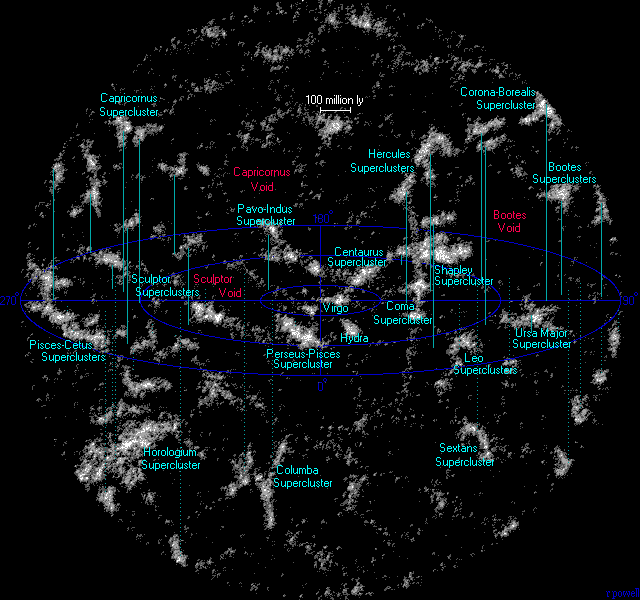Pisces–Cetus Supercluster Complex
The Pisces–Cetus Supercluster Complex is a galaxy filament. It includes the Laniakea Supercluster which contains the Virgo Supercluster lobe which in turn contains the Local Group, the galaxy cluster that includes the Milky Way.[1] This filament is adjacent to the Perseus–Pegasus Filament.[2] Astronomer R. Brent Tully of the University of Hawaii's Institute of Astronomy identified the Complex in 1987.[3]
Extent
[edit]The Pisces–Cetus Supercluster Complex is estimated to be about 1.0 billion light-years (Gly) long and 150 million light years (Mly) wide. It is one of the largest structures known in the observable universe, but is exceeded by the Sloan Great Wall (1.3 Gly), Clowes–Campusano LQG (2.0 Gly), U1.11 LQG (2.5 Gly), Huge-LQG (4.0 Gly), and Hercules–Corona Borealis Great Wall (10 Gly), respectively.
Sixty clusters comprise the complex, which is estimated to have a total mass of 1018 M☉.[4] According to the discoverer, the complex is composed of 5 parts:
- The Pisces–Cetus Supercluster
- The Perseus–Pegasus chain, including the Perseus–Pisces Supercluster
- The Pegasus–Pisces chain
- The Sculptor region, including the Sculptor Supercluster and Hercules Supercluster
- The Laniakea Supercluster, which contains our Virgo Supercluster (Local Supercluster) as well as the Hydra–Centaurus Supercluster.[4]
With its mass of 1015 M☉, our Virgo Supercluster accounts only for 0.1 percent of the total mass of the complex.
The complex was named after the Pisces–Cetus Superclusters, which are its richest superclusters.
Image
[edit]
See also
[edit]References
[edit]- ^ Tully, R. B. (April 1986). "Alignment of clusters and galaxies on scales up to 0.1 C". The Astrophysical Journal. 303: 25. Bibcode:1986ApJ...303...25T. doi:10.1086/164049. ISSN 0004-637X.
- ^ Tully, R. Brent; Courtois, Hélène; Hoffman, Yehuda; Pomarède, Daniel (September 2014). "The Laniakea supercluster of galaxies". Nature. 513 (7516): 71–73. arXiv:1409.0880. doi:10.1038/nature13674. ISSN 0028-0836. PMID 25186900.
- ^ Noble Wilford, John (November 10, 1987). "Massive Clusters of Galaxies Defy Concepts of the Universe". The New York Times.
- ^ a b Tully, R. Brent (December 1987). "More about clustering on a scale of 0.1 C". The Astrophysical Journal. 323: 1. Bibcode:1987ApJ...323....1T. doi:10.1086/165803. ISSN 0004-637X.